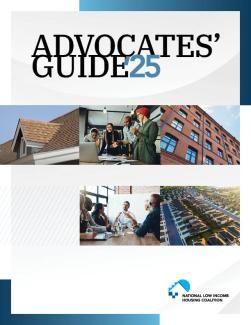Now Available: Advocates' Guide 2025!
Every year, the National Low Income Housing Coalition publishes the Advocates’ Guide to educate advocates of all kinds about the programs and policies that make housing affordable to low-income people across America.
All of us can effectively advocate for housing programs with our members of Congress and other policy makers.
Whether you are a student in an urban planning program, a new employee at a housing agency or community development corporation, or a seasoned affordable housing advocate looking for a refresher on key programs, this resource will give you the overview of housing programs and advocacy tools you need to be a leader in the affordable housing movement and to advocate effectively for socially just housing policy for low-income Americans.
Chapter 2: Advocacy Resources
- How Federal Laws Are Made
- The Federal Budget and Appropriations Process
- FY25 Budget Chart for Selected Federal Housing Programs
- Congressional Advocacy and Key Housing Committees
- Federal Administration Advocacy
- Using Federal Data Sources for Housing Advocacy
- Introduction to the Federal Regulatory Process
- Using the “Freedom of Information Act” for Housing Advocacy
- Overcoming NIMBY Opposition to Affordable Housing
- Lofty Rhetoric, Prejudiced Policy: The Story of How the Federal Government Promised—and Undermined—Fair Housing
- Resident and Tenant Organizing
- Creating and Participating in a Tenant-Led Advocacy Group
- Our Homes, Our Votes: A Guide to Nonpartisan Voter and Candidate Engagement for the Housing and Homelessness Field
- Best Practices and Lessons Learned: Building Multi-Sector Coalitions
- Advocacy and Lobbying Tips for Communities and Beyond
- Lobbying: Important Legal Considerations for Individuals and 501(c)(3) Organizations
- Working with the Media
- The HoUSed Campaign
Chapter 4: Rental Housing Program for the Lowest Income Households
- Housing Choice Vouchers
- Project-Based Vouchers
- Tenant Protection Vouchers
- Vouchers: Family Unification Program
- Vouchers: Foster Youth to Independence Initiative
- Mainstream and Non-Elderly Disabled (NED) Vouchers
- Veterans Affairs Supportive Housing Vouchers
- Public Housing
- Rental Assistance Demonstration (RAD)
- Repositioning of Public Housing: Demolition/Disposition, Voluntary Conversion to Vouchers, and Rental Assistance Demonstration (RAD)
- Moving to Work (MTW) Demonstration and Expansion
- Project-Based Rental Assistance
- Section 202: Housing for the Elderly
- Section 811: Supportive Housing for Persons with Disabilities Program
- National Standards for Physical Inspection of Real Estate (NSPIRE)
- USDA Rural Rental Housing Programs
- Housing Opportunities for Persons with AIDS (HOPWA)
- McKinney-Vento Homeless Assistance Programs
- Homeless Assistance: Advocating to Use Federal Surplus Property to Create More Affordable Housing
- Renters' Tax Credit
Chapter 5: Additional Housing Programs
- HOME Investment Partnerships Program
- Low-Income Housing Tax Credits
- Housing Bonds
- The Affordable Housing Program and Community Investment Program of the Federal Home Loan Banks
- Native American, Alaska Native, and Native Hawaiian Housing Programs
- Self-Help Homeownership Opportunity Program
- Federal Housing Administration
- State and Local Housing Trust Funds
- Emergency Housing Voucher Program
- COVID-19 Relief Legislation and the Coronavirus State and Local Fiscal Recovery Funds (SLFRF) Program
Chapter 6: Special Housing Issues
- Lead Hazard Control and Healthy Homes
- Housing Needs of Survivors of Domestic Violence, Dating Violence, and Stalking
- Housing Needs of Survivors of Sexual Assault
- Inclusionary Housing Policies
- Manufactured Housing
- Olmstead Implementation
- Housing Access for Individuals Formerly Incarcerated and Convicted
- Criminalization of Homelessness
- The Mortgage Interest Deduction
- Why Housing Advocates Should Care About Medicaid in 2025
- Housing Access for Immigrant Households
- Land Use Restrictions and Affordable Housing
- Shelter Access for Transgender People Experiencing Homelessness
- The Preservation of Affordable Housing
- Emergency Rental Assistance
- Federal Housing Protections for People with Disabilities
- Limited English Proficiency (LEP) and HUD Programs
Chapter 7: Tenant Protections and Eviction Prevention
- Strengthening Renters' Rights: Empowering Renters Through State and Local Tenant Protections
- Eviction Record Sealing and Expungement
- Rent Regulation
- Promoting Housing Stability through Just Cause Legislation
- Right to Counsel for Tenants Facing Eviction
- Reimagining Housing Court: A Framework for Court-Based Eviction Diversion
- The National Tenants Bill of Rights: A Policy Platform for Federal Tenant Protections
Chapter 8: Housing Tools
- Housing Counseling Assistance
- Fair Housing Programs
- Disparate Impact
- Affirmatively Furthering Fair Housing (AFFH)
- Consolidated Planning Process
- Public Housing Agency Plan
- The “Community Reinvestment Act”
- Section 3: Job Training, Employment, and Business Opportunities Related to HUD Funding
- Continuum of Care Planning
- Housing First
- HUD-Funded Service Coordinator Programs: Resident Opportunities and Self-Sufficiency Service Coordinator Program, Family Self-Sufficiency, and Service Coordinators in Multifamily Housing for Elderly and Disabled
